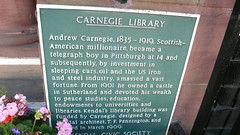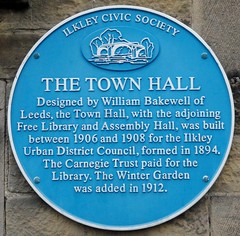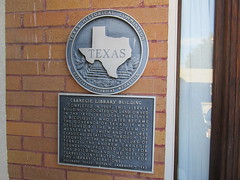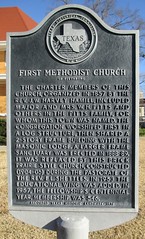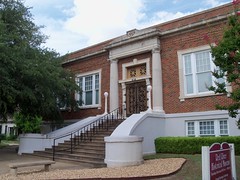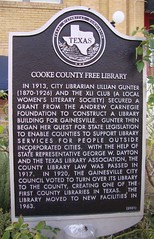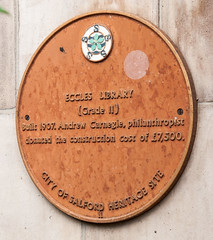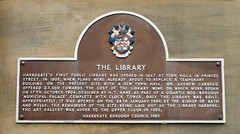Andrew Carnegie
Commemorated on 39 plaques
Beaches Branch, Toronto Public Library 1916 Designed in 17th-century English Collegiate style, Beaches Branch by Kew Gardens replaced a storefront library opened in 1914 at the corner of Queen Street East and Hambly Avenue. The new building was one of three nearly identical libraries (together with Wychwood and High Park) built with a $50,000 grant to the Toronto Public Library from the Carnegie Corporation of New York. George Locke, the chief librarian, wanted the three buildings to "bring to the mind of the people of the outlying districts some recollection of their Scottish and English village type of architecture." The Toronto architecture firm Eden Smith and Sons completed the design, "a decided revolt" from the Classical styling of earlier Carnegie libraries. The brick and stone building features an upper floor modelled on a Tudor Gothic great hall. It boasts a soaring hammer-beamed ceiling, a plain stone fireplace, lead-glass casement windows, and a minstrel gallery. The west wing, built when the library was renovated and restored in 2005, replaces a 1980 addition.
2161 Queen Street East, Toronto, ON, Canada where they funded
Limerick City Art Gallery. The Carnegie Building opened originally in 1906 as a free library and museum. It was funded by Andrew Carnegie
Pery Square, Newtown, Limerick, Ireland where they funded
Carnegie Library. Grade II Listed building. Designed by W Jacques and erected in 1905. Funded by Andrew Carnegie, the Scottish born philanthropist and steel magnate from Pittsburg, Pennsylvania
Lea Bridge Road Library Leyton E10, London, United Kingdom where they funded
Adam Smith Halls. Planned by Provost Michael Beveridge (1835 - 90). Opened in 1899 by Andrew Carnegie in recognition of Kirkcaldy's greatest citizen Adam Smith (1723 - 90) author of "Wealth Of Nations".
Adam Smith Theatre, Bennochy Road, KY1 1ET, Kirkcaldy, United Kingdom where they opened (1899)
Carnegie Library. Andrew Carnegie, 1835-1919, Scottish-American millionaire, became a telegraph boy in Pittsburgh at 14 and subsequently, by investment in sleeping cars, oil and the US iron and steel industry, amassed a vast fortune. From 1901 he owned a castle in Sutherland and devoted his wealth to peace studies, education, and endowments to universities and libraries. Kendal's library building was funded by Carnegie, designed by a Kendal architect, T.F. Pennington, and opened in March 1909.
Stricklandgate, Kendal, United Kingdom where they funded (1909)
The Town Hall. Designed by William Bakewell of Leeds, the Town Hall, with the adjoining Free Library and Assembly Hall, was built between 1906 and 1908 for Ilkley Urban District Council, formed in 1894. The Carnegie Trust paid for the Library. The Winter Garden was added in 1912.
Station Road, Ilkley, United Kingdom where they funded
Texas Historical Marker #00731
Carnegie Library Building. A Cleburne Public Library was begun in 1901 under the direction of the local women's club. In 1902 members of the organization met with New York industrialist and benefactor Andrew S. Carnegie to secure funds for a building. His gift was matched by local contributions and this structure was completed in 1905. Featuring details of the beaux arts and classical revival styles and a second floor theater, it housed the library until 1978. Recorded Texas Historic Landmark - 1981 #731
?, Cleburne, TX, United States where they funded
Texas Historical Marker #00732
Carnegie Library Building. This native limestone library was built in 1909-11 with funds from New York industrialist and philanthropist Andrew Carnegie. Local banker Jo Wilmeth donated the land and the Rev. J. D. Leslie, pastor of the First Presbyterian Church, served as the supervising architect. The building's auditorium and club rooms were used for a variety of civic and cultural events, school social activities and temporary worship services of several local churches. Recorded Texas Historic Landmark - 1962 #732
204 8th St., Ballinger, TX, United States where they funded
Texas Historical Marker #00733
Carnegie Library Building. Completed in 1904, this brick library building was funded by a personal contribution from the noted New York industrialist and benefactor Andrew S. Carnegie. Ben D. Lee, builder of the Bell County Courthouse, served as contractor. Designed by the firm of Smith and Moore and made of bricks from a local kiln, the structure features elaborate detailing of the Beaux Arts classical style. When the library opened in 1905, 1500 volumes were contributed by members of the Woman's Wednesday Club. Public library facilities were located here until 1975. Recorded Texas Historic Landmark - 1981 #733
201 N. Main, Belton, TX, United States where they funded
Texas Historical Marker #02028
Fort Worth Library. Seeking funds for a public library, local woman asked the philanthropist, Andrew Carnegie, to donate "The price of a good cigar". He gave $50,000. With that and substantial local gifts, including land donated by Mrs. Sarah J. Jennings, the first City Library opened on this site, 1901. First Librarian, Mrs. Charles Schevber, was active in parks movement and local art circles. She was Vice President, 1911-1917, American Federation of Art. The old library was razed in 1938. This building in modern Classic style is four times as large as the original Library. (1968) #2028
Houston & 9th St., Fort Worth, TX, United States where they funded
Texas Historical Marker #05223
Temple Public Library. On March 29, 1900, the Women's Literary Club and the Self Culture Club formed a city federation for the purpose of organizing a public library. Soon the first library opened in a corner of the post office building and later moved to a book store. In 1901 the national library program of steel millionaire Andrew Carnegie funded a library building. The new structure was opened in 1904 in the center of the city park at First and Central Avenue. Citizens headed by Mrs. W.S. Banks held fund drives to operate the facility until 1907 when the city appropriated revenue. In 1918, fire destroyed the building. The library reopened in 1924 and was housed in various business until 1929 when it moved into the Municipal Building. Women of the library board ran the program until the city took over in 1954. After a new postal facility was erected in 1963 the city received this 51-year-old post office building for a library. The Renaissance Revival edifice was remodeled in 1964 using funds from a bond issue and the Carnegie Library Association. A memorial room was named for W. Goodrich Jones, one of the library's benefactors. This facility is a member of the Central Texas Library Association and provides a full program. Recorded Texas Historic Landmark - 1978 #5223
101 N. Main, Temple, TX, United States where they funded
Texas Historical Marker #05892
Woman's Wednesday Club of Belton. Founded in 1898 as a literary society with twenty-five members, the Woman's Wednesday Club is the oldest active club of its kind in Bell County. Initially meeting in the Central Hotel in downtown Belton, the club members were devoted to the study of literature and history. Each member donated books to begin a library. They were instrumental in persuading Andrew Carnegie to donate funds to the city for a public library, and their collection of books formed the nucleus of the institution's holdings. The club has been a driving force in the cultural life of the city. (1990) #5892
201 N. Main, Belton, TX, United States where they funded
Texas Historical Marker #07825
Public Libraries of Greenville. In 1903 the Woman's Review Club organized the Greenville Public Library. Various locations were used until a building at 2713 Stonewall was funded by the National Library Program of the steel millionaire, Andrew Carnegie. The city Federation of Women's Clubs provided books and maintained the library. The first Catholic church in the city was located on this lot. In 1953 the city acquired the church property. The next year this structure was completed. The library was renamed in 1976 for civic leader, W. Walworth Harrison. #7825
3716 Lee St., Greenville, TX, United States where they funded
Texas Historical Marker #08059
Jefferson Public Library. Built 1907 by local funds plus a gift from Andrew Carnegie Foundation-- one of 34 such grants made in Texas (where the movement for public libraries had begun in 1881). A center of interest in a culture-loving town. Recorded Texas Historic Landmark - 1966 #8059
Lafayette and Marrion, Jefferson, TX, United States where they funded
Texas Historical Marker #08788
Palestine Carnegie Library. Outgrowth of 1853 effort by Judge John Graham Gooch to see circulating library established in Palestine, at first lending his own books. Original city library was replaced by this structure, built 1914 with aid from the Carnegie Foundation. Recorded Texas Historic Landmark - 1970 #8788
502 N. Queen St., Palestine, TX, United States where they funded
Texas Historical Marker #09425
Carnegie Library Building. Completed in 1904, this library building is located on land owned in the 1890s by local publisher O. B. Colquitt, who later became the governor of Texas. It was designed by the Waco firm of Messer and Smith and features classical detailing. Through the efforts of the women's clubs of Terrell, the Andrew Carnegie Foundation provided funds for the building, and the city of Terrell contributed money for the library operations. Recorded Texas Historic Landmark - 1983 #9425
207 N. Frances St., Terrell, TX, United States where they funded
Texas Historical Marker #09426
Carnegie Public Library. Opened 1904 through the efforts of local women's clubs. Building a gift of public benefactor Andrew Carnegie. Only library in Kaufman County; has been information center for students of five local colleges and a site of early civic functions. Has over 14,000 books. #9426
207 N. Frances, Terrell, TX, United States where they funded
Texas Historical Marker #09795
Site of First Carnegie Library in Texas. At 1898 request of firm mining coal in Pittsburg, philanthropist Andrew Carnegie gave $5,000.00 to match local pledges and build the first Carnegie Library (of 31) in Texas on this site. the masonry building was also the opera house and city hall. Library had 3,000 books. It became a social center, with meeting rooms for clubs and groups such as ladies sewing for World War I hospitals. The opera house staged professional drama and lectures and was used for graduations and recitals until modern school was built in 1926. The library burned in 1939. #9795
200 Rusk St., Pittsburg, TX, United States where they funded
Texas Historical Marker #10925
Franklin Carnegie Library. The city of Franklin housed a library of 1,000 volumes in its City Hall before 1913. In February that year, Franklin Mayor R. M. Cole (1848-1931) applied to the Carnegie Corporation of New York for funds to build a new library. The Carnegie Corporation approved plans and granted $7,500 to the project. This brick building with classical details and a pressed-metal roof resembling tiles was designed by an architect named Patterson and completed in 1914, though it served as a library only through 1918. School classes and public activities were held here through 1984. Recorded Texas Historic Landmark - 1986 #10925
Decker and Owensville St., Franklin, TX, United States where they funded
Texas Historical Marker #11538
Old Sherman Public Library. A subscription library was established in Sherman in 1901 and housed in a rented room. In 1911, the city submitted a request to the Andrew Carnegie Foundation and received $20,000 for a library. This lot was purchased in 1912 for $2500 and plans were drawn for a structure of simplified beaux-arts styling by local architect John Tulloch (1860-1947). The building served as a library from 1915 until 1973. Of note are the three interior murals, completed in 1934. Recorded Texas Historic Landmark - 1986 #11538
301 S. Walnut, Sherman, TX, United States where they funded
Texas Historical Marker #11608
Corsicana Public Library. The women's clubs of Corsicana were instrumental in opening the city's first public library in 1901 at W. 6th and Main St. The city created a library board in 1904 and secured a construction grant from the Carnegie Corporation the following year. In 1906 the Carnegie Library opened at W. Collin and N. 12th St. The building included a large auditorium which held numerous community gatherings. Mrs. Mattie Houston served as head librarian from 1908 until the 1940s. A new library was completed in 1967 to house a collection that had grown to over 40,000 volumes. #11608
100 N. 12th St., Corsicana, TX, United States where they funded
Texas Historical Marker #12435
Belle Sherman Kendall. The daughter of Texas revolutionary war general Sidney Sherman and Catherine Isabell (Cox), Belle Sherman (1847-1919) was born in Harrisburg and married William E. Kendall in 1867. After making Houston her home in 1878, Belle S. Kendall became a noted civic leader. She was a founding member of the Daughters of the Republic of Texas and the Woman's Club of Houston. Under her leadership, the Woman's Club played a pivotal role in developing the Houston Public Library system. After securing funds from philanthropist Andrew Carnegie for the city's first public library building, Belle was honored at the cornerstone ceremony in 1902. In 1969 a branch library was named in her honor. (2001) #12435
2525 Washington Ave., Houston, TX, United States where they funded
Texas Historical Marker #12599
Cooke County Free Library. In 1913, city librarian Lillian Gunter (1870-1926) and the XLI club (a local women's literary society) secured a grant from the Andrew Carnegie Foundation to construct a library building for Gainesville. Gunter then began her quest for state legislation to enable counties to support library services for people outside incorporated cities. With the help of state representative George W. Dayton and the Texas Library Association, the County Library Law was passed in 1917. In 1920, the Gainesville City Council voted to turn over its library to the county, creating one of the first county libraries in Texas. The library moved to new facilities in 1963. (2001) #12599
201 S. Denton St., Gainesville, TX, United States where they funded
Texas Historical Marker #13093
Houston Public Library. Within 10 years of its founding in 1836, Houston was a bustling city. Throughout the 1840s, the city's professionals came together in debating societies to discuss a variety of topics. They created the Houston Circulating Library to provide reference materials for their debates. In 1854, they organized the Houston Lyceum. By 1857, the group, which was limited to white, dues-paying males, had almost 800 books in its collection. In 1887, 30 years later and with more than 2,400 books, the Lyceum opened its membership to women. For the next several years, the women members proved to be persistent advocates for creating a public facility. By 1895, the Lyceum provided limited access to non-member adults of Houston. The following year, the library became available to local high school students. In 1899, Houston's city council appropriated money to maintain a free library. Mrs. W. E. Kendall and Mamie Gearing of the Houston Woman's Club wrote a letter to philanthropist Andrew Carnegie, who offered $50,000 for a building. Local organizations, including what had become the Houston Lyceum and Carnegie Library Association, as well as private citizens and businesses, raised money to purchase a site at the corner of McKinney Avenue and Travis Street. The city hired Martin and Moodie Company to design and build the new library, which opened on March 2, 1904 as the Houston Lyceum and Carnegie Library. Under the direction of Julia Ideson, city librarian from 1903 to 1945, the library expanded its services to include several branches and a bookmobile. Ideson oversaw construction in 1926 of a larger central facility, later named in her honor. Her successors continued her work, providing one of the nation's largest cities with books and programs in a variety of locations and languages. (2004) #13093
500 McKinney Ave, Houston, TX, United States where they funded
Texas Historical Marker #13167
Library Movement in Greenville. Library Movement in Greenville In 1897, Greenville's Chautauqua Literary and Social Circle formed the Women's Review Club, which aimed to create a circulating library; each member donated books. The Review Club opened their library in 1900. By 1903, the popular library had to move to larger facilities. The club sought funds from philanthropist Andrew Carnegie, who offered $15,000 for a building. The local Federation of Women's Clubs, under leadership of may Moulton Harrison, provided the site, and the City formed a board of trustees for the public library, which opened in 1904. The library moved to new facilities in 1954 and again in 1996. Renamed for local historian W. Walworth Harrison, the son of May Harrison, the library continues to serve its community. (2003) #13167
1 Lou Finney Ln, Greenville, TX, United States where they funded
Texas Historical Marker #13888
Julia Ideson Building. Early efforts by Houston's Lyceum, local women's organizations and Andrew Carnegie's national foundation led to the 1904 Houston Lyceum and Carnegie Library Building. Julia Bedford Ideson, hired in 1903, was the city's first librarian. Under her direction, the library's collection and services expanded until, by 1920, the 1904 building was too small. The city continued to use the building, known by the 1920s as the Houston Public Library, until 1926, when the new library building opened at this site. Ideson and the library building committee worked throughout the 1920s to formulate a plan and program for the new structure, visiting other U.S. cities and accepting proposals from several noted architects. They chose Ralph Adams Cram and his Boston firm, Cram and Ferguson, for the project. Cram worked with local architects William Ward Watkin and Louis A. Glover, coordinating also with the city's architect, W.A. Dowdy. The Southwestern Construction Company served as the builder. Noted for his design work throughout the Northeast, Cram chose the Spanish Renaissance Revival style for Houston's library. Details include tile roof, arched openings, cast stone window surrounds, finials lining the parapet wall, and ornate metalwork. The L-shaped building's materials are primarily brick, cast stone and limestone. After more than 40 years as Houston's librarian, Ideson died in 1945. The city renamed the library six years later to honor her contributions to Houston's library program, as well as her involvement in numerous civic groups and professional associations. Although the city's library facilities and services have continued to expand since the Ideson Building's construction in 1926, the structure continues to serve as a library and local landmark. Recorded Texas Historic Landmark - 2003 #13888
500 McKinney, Houston, TX, United States where they funded
Carnegie Hero Fund Commission. Established April 15, 1904, by Andrew Carnegie. The Pittsburgh-based foundation awards the Carnegie Medal in the U.S. and Canada to persons who risk their lives to save others. Heroic acts that followed the January 25, 1904, explosion in the nearby Harwick Mine inspired Carnegie, who also founded ten similar funds in Europe. Many of the explosion's 181 victims are buried in St. Mark's Cemetery just south of here.
301 Pittsburgh St. (SR 1001, old PA 28), Springdale, PA, United States where they founded
Duquesne Steel Works. Plant here began in 1886. Acquired by Andrew Carnegie, 1890; by U.S. Steel, 1901. Workers here implemented advances in rolling mill & blast furnace processes before 1914; in pollution control, 1953. At peak of operations they manned six blast furnaces. Plant was in service until 1984.
E Grant Ave. & Linden St. (PA 837), Duquesne, PA, United States where they was
Scotia. Two miles southwest of here, an iron center called Scotia was established by Andrew Carnegie in 1881. Here houses were erected, a railroad built, and machinery set up. Some physical traces of the center have remained.
off the Gray's Woods exit of US 220/322, on Gray's Woods Blvd. / Scotia Rd., Patton Township, PA, United States where they was
Wyoming Branch of the Free Library. The last library funded by noted philanthropist Andrew Carnegie opened here October 30, 1930, as the Wyoming Avenue Branch of the Free Library of Philadelphia. Pittsburgh industrialist Carnegie endowed more than 2,500 libraries worldwide, including many in Philadelphia.
231 E Wyoming Ave., at "B" St., Philadelphia, PA, United States where they funded
City of Salford Heritage Site #11
Eccles Library (Grade II) Built 1907. Andrew Carnegie, philanthropist donated the construction cost of £7,500
28 Barton Lane, Eccles, United Kingdom where they funded
The library. Harrogate's first public library was opened in 1887 at Fern Villa in Princes Street. In 1903, when plans were already afoot to replace a temporary building on the present site with a new town hall, Mr Andrew Carnegie offered £7,500 toward the cost of the library wing on which work began on 17th October 1904. Designed by H.T. Hare as part of a gigantic neo-baroque 'municipal place' complete with clock tower, only the library was built. Appropriately, it was opened on the 24th January 1906 by the Bishop of Bath and Wells, the remainder of the site being laid out as the library gardens. The art gallery was added to the upper floor in 1930.
Victoria Avenue, Harrogate, United Kingdom where they funded
Carnegie Library 1906 This free public library was erected by St Annes UDC and funded by Scottish-American philanthropist Andrew Carnegie. The architect was JD Harker and the builder Samuel Wilson, both of St Annes. The site was gifted by the St Annes on Sea Land & Building Company Ltd. In 1931 the reference and children's libraries were added by Lytham St Annes Council and built by John Heap & sons of St Annes.
254 Clifton Drive South, St Annes on Sea, United Kingdom where they funded
Carnegie Birthplace On 25th November 1835, Andrew Carnegie was born in this humble 17th century weaver's cottage. The Carnegie family lived in one room upstairs and another family lived in the adjoining cottage. The adjacent Memorial Hall (by architect James Shearer) was added in 1928.
Priory Lane, Dunfermline, United Kingdom where they was born (1835)
Andrew Carnegie Birthplace Museum Andrew Carnegie, millionaire and philanthropist, was born in this cottage on the 25th November 1835.
Priory Lane, Dunfermline, United Kingdom where they was born (1835)
Carnegie Library. Andrew Carnegie funded 2,811 free libraries around the world. This was the very first of them opened in 1883 at a total cost of £8000. The architect was JC Walker. James Shearer extended the building in 1914-21 and it was further extended in 1993.
Abbot Street, Dunfermline, United Kingdom where they funded
The Old Library - 1904 Carnegie libraries were built across the world between 1883 and1929 to help the 'industrious and ambitious' benefit from education.
Leeming Street, Mansfield, United Kingdom where they was
Andrew Carnegie Statue. This bronze statue erected to Dunfermline's most famous son was paid for by public subscription. The sculptor was Richard Goulden. 20,000 people attended its unveiling in 1914.
Pittencrieff Park, Dunfermline, United Kingdom where they Lived here
Carnegie Hall. A smaller version of its New York namesake, this was the last public building to be gifted to Dunfermline by Andrew Carnegie's endowment. In classical Modern design (Muirhead and Rutherford, 1937). It hosts many arts events.
East Port, Dunfermline, United Kingdom where they funded



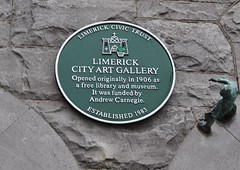
.jpg?width=250)

